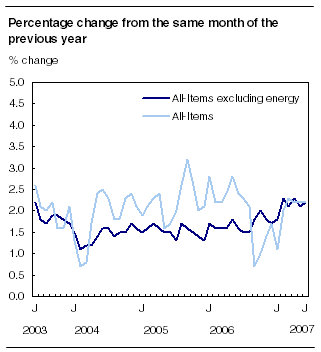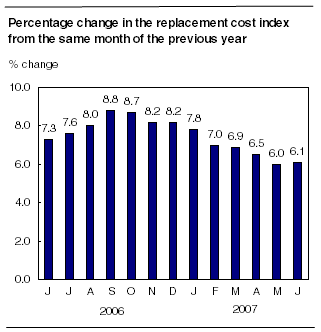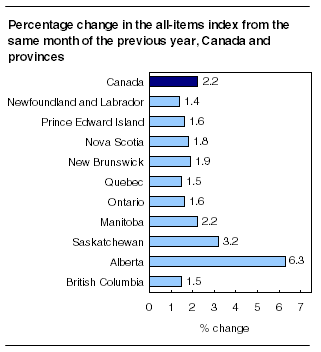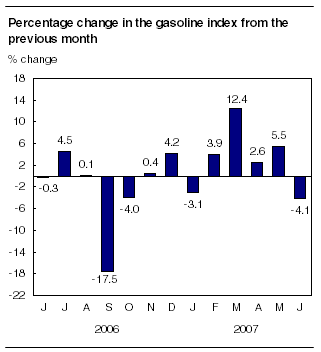Common menu bar links
Consumer Price Index
Archived Content
Information identified as archived is provided for reference, research or recordkeeping purposes. It is not subject to the Government of Canada Web Standards and has not been altered or updated since it was archived. Please "contact us" to request a format other than those available.

Consumer prices rose by 2.2% in June compared with June 2006, identical to the increases in both April and May.

For the third straight month, most of the growth in average price levels was attributable to costs associated with owned accommodation (+4.9%). Also a factor, but to a lesser extent, was a 2.8% increase in costs associated with operating a vehicle.
A drop in prices for computer equipment and supplies exerted downward pressure on average prices.
Excluding energy, the all-items index rose by 2.2% between June 2006 and June 2007, marginally faster than the 2.1% gain in May.
The Bank of Canada's core index rose 2.5%, faster than the 2.2% increase observed in May. The rise in homeowners' replacement cost accounted for most of this increase. This index is used by the Bank of Canada to monitor the inflation control target. Increases in this index have exceeded 2.0% for the past year.
On a monthly basis, the all-items index declined 0.2% between May and June 2007 after rising 0.4% between April and May. This is the first monthly decline in the all-items index since October 2006. The downturn was largely due to declining gasoline prices and prices for women's and men's clothing.
Both the all-items index without energy and the core index remained unchanged between May and June 2007, following increases of 0.3% between April and May.
12-month change: Higher costs for owned accommodation and motor vehicle operations fuel the growth
The 12-month rise of 2.2% in the Consumer Price Index (CPI) was essentially due to the strength of costs associated with owned accommodation, combined with the growth in costs of operating motor vehicles.

For a third straight month, costs associated with owned accommodation accounted for most of the increase in average price levels over 12 months.
Within this category, the component that contributed the most to the increase was mortgage interest cost, which rose 5.7%, the same growth rate as in May and April. It was the fastest rate of growth since January 2001.
For the past several months, the growth in prices for new houses has been driving the sustained increase in mortgage interest cost.
Homeowners' replacement cost also contributed to the increase in the CPI in June. This component, which represents the worn-out structural portion of housing and is estimated using new housing prices (excluding land), rose by 6.1% between June 2006 and June 2007. This was up slightly from the 6.0% increase observed in May.
This minor upswing in the rate of growth for this component followed seven months of slowdown. June's increase was less than the average monthly change posted since January 2007 (+6.8%).
Drivers saw a 2.8% rise in the cost of operating their vehicles between June 2006 and June 2007, partly the result of higher gasoline prices compared to 2006 levels.
The rise in gasoline prices tapered off somewhat. In June, prices were only 1.7% higher than in June 2006, compared with an increase of 5.8% in May. Automotive vehicle parts, maintenance and repairs (+4.0%) also contributed, to a lesser extent, to the change in vehicle operating costs.
Consumers had to spend 2.3% more for restaurant meals and 3.4% more for food bought in grocery stores in June. The increase in prices for food purchased in stores was largely attributable to meat (+4.6%) and dairy products (+3.7%).
The growth in these components was partly offset by the downward trend in prices for computer equipment and supplies (-17.3%) and video equipment (-9.5%).
Consumers also had to spend less for their clothing. Prices for men's clothing were down 2.7%, while those for women's clothing decreased 2.1%.
Alberta and Saskatchewan residents are hit most by price increases
Consumer prices were up in all provinces and territories between June 2006 and June 2007. However, only two provinces posted increases higher than the national average of 2.2%: Alberta (+6.3%) and Saskatchewan (+3.2%).
In Alberta, the average increase was largely the result of a gain (+15.8%) in the costs for owned accommodation. This was also the case in Saskatchewan, where costs for owned accommodation rose 12.7%.
Growth in replacement cost in Saskatchewan (+31.8%) surpassed that of Alberta (+23.6%) for the first time since September 2005.
The main factor in Saskatchewan was the increase in prices for new houses, sustained by strong employment growth. Growth in the employment rate in Saskatchewan has surpassed the national average from August 2006 to May 2007.

The most moderate growth in prices during this period was observed in Newfoundland and Labrador (+1.4%). Still, this rate of growth was double the 0.7% increase posted in May. The biggest factors in that province's CPI increase were the cost of owned accommodation (+2.6%) and gasoline (+3.3%).
Month-over-month: Gasoline prices main contributor to decline in the CPI
Declining gasoline prices were the main contributor to the 0.2% decrease in the all-items CPI between May and June 2007. Gasoline prices fell by 4.1% during this period, the fastest decline since October 2006. In contrast, gasoline prices were the main contributor to the increase in the CPI between April and May, when they rose 5.5%.
June's decline in gasoline prices was the result of a number of factors, including a recovery in capacity utilization rates at refineries following the completion of maintenance tasks that had affected the supply in May; an increase in inventories, although they were still below the average of the past five years; a reduction in retailers' margins; and the settlement of a labour dispute in Nigeria.

A 4.0% slide in the clothing component between May and June 2007 also contributed to the monthly decrease in the CPI. During this period, prices for women's clothing declined 4.3%, while those for men's clothing declined 4.5%. Changes of this magnitude are common at this time of the year when retailers generally hold promotional sales to reduce their inventories to make room for the following season's collections.
Consumers paid 0.3% less for purchased vehicles in June than in May as dealers offered discounts to reduce inventories.
Energy costs associated with housing moderated the decline in the CPI between May and June 2007. The natural gas index rose by 3.9%. This growth was particularly pronounced in Alberta. Electricity prices increased 1.6%, the fastest growth rate since November 2006.
Homeowners' replacement costs climbed 0.8% on a monthly basis, the fastest increase observed since September 2006.
Available on CANSIM: tables 326-0009, 326-0012, 326-0015 and 326-0020 to 326-0022.
Definitions, data sources and methods: survey number 2301.
More information about the concepts and use of the CPI are also available online in Your Guide to the Consumer Price Index (62-557-XIB, free) from the Publications module of our website.
Available at 7 a.m. online under The Daily module of our website.
The June 2007 issue of the Consumer Price Index, Vol. 86, no. 6 (62-001-XWE, free) is now available from the Publications module of our website. A paper copy is also available (62-001-XPE, $12/$111). A more detailed analysis of the CPI is available in this publication.
The July Consumer Price Index will be released on August 21.
For more information or to enquire about the concepts, methods or data quality of this release, call Client Services (toll-free 1-866-230-2248; 613-951-9606; fax 613-951-1539; prices-prix@statcan.gc.ca), Prices Division.


 Table(s).
Table(s).